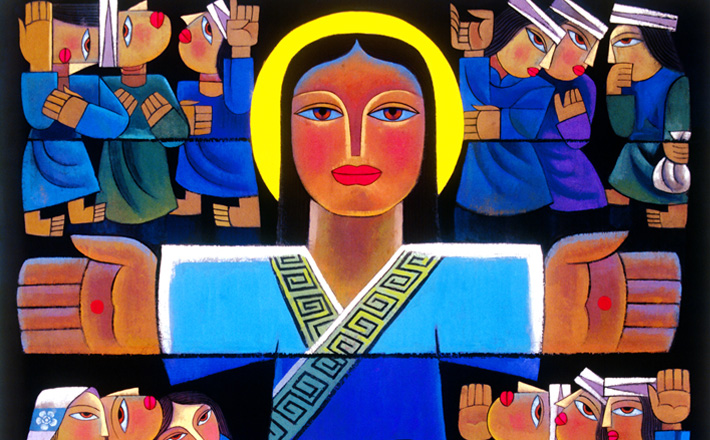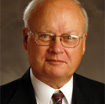Commentary on Luke 24:1-12
Each of the four Resurrection narratives goes its own way in details, but there are three elements that they all have in common: (1) the discovery of the empty tomb takes place on a Sunday morning; (2) Mary Magdalene is present at the tomb; and (3) the tomb is found to be empty.
Beyond that there are differences, and some of the differences are worth noting.
In the case of Luke’s Gospel one of the most notable features is that it has the most women on the scene. Luke puts it this way: “Now it was Mary Magdalene, Joanna, Mary the mother of James, and the other women with them” (24:10). Three are named but others are not. Consequently we have to conclude that, for Luke, at least five are present (three plus “other women,” plural); perhaps more than five is intended.
Two of those named are mentioned back in 8:2-3 (Mary Magdalene and Joanna) and belong to the company of those who provided for Jesus’ ministry out of their means. We are no doubt supposed to think of that company as the ones who were at the crucifixion (23:49), were subsequently at the tomb (23:55), prepared spices and ointments (23:56), and arrived at the tomb in the early dawn on Sunday (24:1).
A second distinctive feature of Luke’s Resurrection narrative is the inclusion of a reminder to the women in 24:7, in which the two men recall the passion predictions of Jesus, which appear at 9:22 and 18:31-33 (plus a shorter version at 9:44 and a hint of the passion in 22:22). As the text stands, we must assume that, according to Luke, the women being addressed were themselves among the followers of Jesus in Galilee who heard Jesus’ predictions. That is possible, since they are among the retinue at 8:2-3, prior to the first prediction in Galilee (9:22).
Distinctive to the saying itself is that here, but not previously, the word “crucified” appears. After the reminder is given, the women do indeed remember (24:8), meaning by implication that they were believers. That must be so, because the reminder includes not only a prediction of the passion, but also of the resurrection. It is on that basis that they go and tell “the eleven and to all the rest” what they had witnessed (24:9).
Finally, Luke includes a brief narrative about the response to what the women reported. The eleven (and others) considered it “an idle tale” and did not believe the report at all (24:11). They were not moved to do anything about it. There was one exception, however, and that was Peter. He ran to the tomb (as in John 20:4), inspected it, and went home “amazed at what had happened” (24:12). Luke does not say that Peter was a confirmed believer at this point.
Later the same day, after the appearance of the risen Christ to Cleopas and another traveler on the road to Emmaus (24:13-32), “the eleven and their companions” are gathered together. It is then that they say, “The Lord has risen indeed, and he has appeared to Simon” (i.e., Simon Peter, 24:34). They make the Easter confession as a chorus of believers, based on the testimony of one of their own. Yet that is still not the end of the drama of the struggle between belief and disbelief. Jesus suddenly appears among the disciples. He chides them for their doubts (24:38), for “they were disbelieving and still wondering” (24:41). It is not until Jesus commissions them as his witnesses and blesses them that the disciples actually worship him (24:48-53).
The way that Luke reports the Easter story takes us back to the way he tells the story of Jesus all along. The opening scenes of his gospel are about women who have a major role to play in the entire drama of redemption, including Elizabeth (1:41-45), Mary (1:38-56), and Anna (2:36-38). Each is a prophetic figure, speaking of the wondrous works of God. There are additional vignettes that feature women as persons of faith throughout the story (7:1-17, 36-50; 8:2-3; 10:38-42; 11:27-28; 13:10-17; 15:8-10; 18:1-8; 23:27-28), all of which are distinctive to Luke. In addition, frequently in the story that Luke tells, Jesus associates with people considered to be sinners (5:30-32; 7:34; 7:36-50; 15:1-2; 18:9-14; 19:7; 23:39-43).
Both of these threads through the story appear in Luke’s post-resurrection accounts. The good news of Easter is announced first to women by angels (called “men in dazzling clothes” in 24:4, which means they were angels; and if we have any doubt, they are called “angels” in 24:23), just as an angel announced the news to Mary that she would be the mother of Jesus (1:26-38).
Then, although it appears much later in the post-resurrection accounts (not in 24:1-12 itself), there is the scene of the risen Jesus who declares that “repentance and forgiveness of sins is to be proclaimed in his name to all nations, beginning from Jerusalem” (24:47). Jesus’ fellowship with sinners lives on.
Some thoughts can be developed out of the story that Luke tells, but one need not be confined to Luke’s account. It shares and coheres with other affirmations of the Easter gospel in the New Testament.
(1) Easter is perplexing, and to believe in the resurrection is not easy. The women who come to the tomb are perplexed from the beginning, and the apostles, when they hear the report of the women to them, consider it an “idle tale.” It is only later on that the apostles come to faith, and that is after Jesus appears to them as the story unfolds.
To believe in the resurrection of Jesus takes a lot of faith and courage. But it is more than saying yes to the claim made by the women and, eventually, the men in the Easter story. It is at the same time saying “no” to the power of death and destruction that surrounds us. In place of the bad news we hear and the bad experiences we have, we make the claim that there is a sustaining power, God, who brings life out of death and reconciliation out of conflict, as the Bible tells us. There has been marvelous testimony through the ages that that is so, beginning with the earliest witnesses of Easter. To commit ourselves to their claim opens the door to new life for ourselves and for acts of love and reconciliation in the world.
(2) Easter marks a moment in time when God raised the lifeless body of Jesus from death to life, thus vindicating all that Jesus taught and did in his earthly ministry. That was a ministry of inclusion, not only of women (so prominent in the story), but also of Gentiles (2:30-32; 13:29; 14:15-24) and persons regarded by the majority as sinners.
The tendency exists for people to divide the world up along racial, ethnic, and gender lines and more. Some of that is inevitable and can be for good purposes. But there is a downside to it too. The divisions that people make between the respectable and the disgraceful, the good and the bad, or saints and sinners can be particularly troublesome. Such judgments are often unfair. The problem that Jesus faced was that some people were written off as sinners, because they did not measure up to standards that those who thought of themselves as righteous had set up. They were therefore to be avoided. Jesus sought to break down the false barriers and became a friend of those considered to be sinners. Respect for all, and a welcome for all, is the legacy that Jesus has given to his church.
(3) Easter also marks the beginning of a new creation. It begins with the resurrection of Jesus, and it continues in the passing of time where the gospel is proclaimed and people come to faith. As the apostle Paul put it, “whoever is in Christ is a new creation” (2 Corinthians 5:17).
The church at its best continues to be the community of the new creation in a world that is too often headed for dissolution by violence, abuse, death, and destruction. Being people of the resurrected Lord Jesus, the church is in the business of praying for the renewal of the world and seeking to renew it.
In Evangelical Lutheran Worship there is a service for Morning Prayer (pages 304-308). It contains a prayer that reminds us that we are people of the resurrection. In one of its petitions the congregation prays:
Mighty God of mercy, we thank you for the resurrection dawn, bringing the glory of our risen Lord who makes every morning new.
And then, shortly after that, the congregation prays:
Merciful God of might, renew this weary world, heal the hurts of all your children, and bring about your peace for all in Christ Jesus, the living Lord.
In the life of the church, Easter is a once a year event, strictly speaking, but every Lord’s Day throughout the year is a “little Easter,” the weekly celebration of the day of resurrection, “the eighth day” of creation,1 the day of new creation. It is also an occasion for the church to claim the resurrection promise that God is making all things new, beginning with the resurrection of Jesus from the dead. As the body of believers who belong to the risen Christ, the church is the community of the new creation.
1Epistle of Barnabas 15:8-9 (early second century): Further, [God] says to them, “Your new moons and your Sabbath I cannot endure.” Ye perceive how He speaks: Your present Sabbaths are not acceptable to Me, but that is which I have made, namely this, when, giving rest to all things, I shall make a beginning of the eighth day, that is, a beginning of another world. Wherefore, also, we keep the eighth day with joyfulness, the day also on which Jesus rose again from the dead. And when He had manifested Himself, He ascended into the heavens.


March 31, 2013